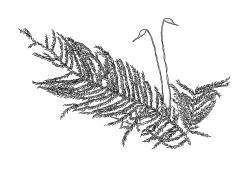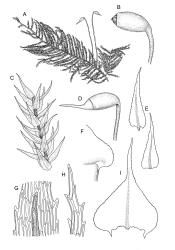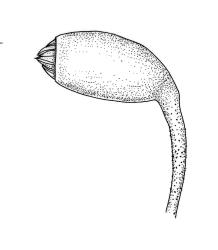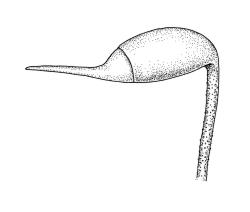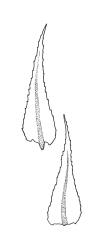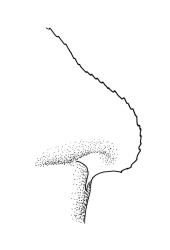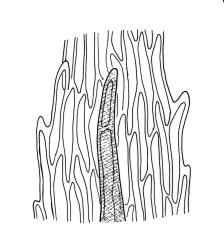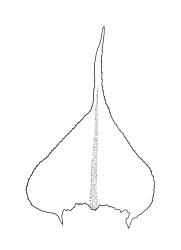- ≡ Hypnum praelongum Hedw., Sp. Musc. Frond. 258 (1801)
- ≡ Oxyrrhynchium praelongum (Hedw.) Warnst., Krypt.-Fl. Brandenburg, Laubm. 781 (1905)
- ≡ Stokesiella praelonga (Hedw.) H.Rob., Bryologist 70: 39 (1967)
- ≡ Kindbergia praelonga (Hedw.) Ochyra, Lindbergia 8: 54 (1982)
Plants medium-sized, bright green or yellow- or brown-green, forming rather rough and irregular wefts, often on acidic, wet soil. Stems creeping, irregularly branching, elongate, commonly 40–100(–130 mm) long. Branches ascendant, often rigid, simple or more often irregularly branched, variable in length. Stem leaves rather distant, widely spreading to squarrose, abruptly acuminate from a broadly ovate-cordate base, plane and sharply serrulate at margins, strongly decurrent, plicate when dry, mostly (1.1–)1.3–1.5 × 0.8–0.95 mm (excluding the decurrencies); costa tapered, ending near base of the acumen, apparently lacking a terminal spine; mid laminal cells linear-rhomboid, firm-walled, smooth, mostly 36–60 × c. 6 µm, becoming shorter, thicker-walled, and porose near insertion; cells of the acumen not differentiated; alar cells inflated and often clear, forming a large but poorly-defined, intra-marginal group, which nearly fills the auricle and grades into the oblong cells of the decurrency. Branch leaves strongly differentiated, not or scarcely complanate, ovate-lanceolate, often weakly acuminate, narrowed and symmetric at base, mostly 0.7–1.0 × 0.35–0.4 mm; alar cells differentiated and subquadrate; costa extending c. ¾ the leaf length, stout and nearly uniform in width throughout (poorly illustrated in fig. e), with a terminal abaxial spine. Paraphyllia lacking in N.Z. material.
Dioicous. Perichaetia rather inconspicuous and scattered on stems, c. 1.5 mm long, the inner leaves strongly squarrose and ecostate, surrounding c. 12–15 archegonia and numerous filiform and hyaline paraphyses. Perigonia scattered on main stems and branches, c. 1.5 mm long, the bracts erect, narrowly ovate-acuminate or lanceolate, surrounding c. 6 antheridia. Setae slender and elongate, strongly sinistrorse, c. 25 mm, red-brown, finely papillose throughout (not visible under hand-lens); capsules short, oblong-cylindric, narrowed below mouth when dry, ± horizontal, c. 2.0 mm; exothecial cells mostly rounded-oblong, thick-walled, scarcely thickened in corners; stomata not seen; operculum ± equal the capsule. Exostome teeth as for genus, c. 500 µm; endostome as for genus; cilia 2–3 (apparently variable within a single capsule). Spores 10–15 µm, smooth.
Crum & Anderson 1981, fig. 528 (as Stokesiella praelonga); Meagher & Fuhrer 2003, p. 59; Smith 2004, fig. 286, 1–6 (as Kindbergia praelonga).
NI: N Auckland including offshore islands (GB, LB, Waiheke), S Auckland, Hawke’s Bay (near Wairoa, Waihau), Wellington; SI: Nelson, Marlborough, Canterbury, Westland, Otago, Southland; St; Ch.
Adventive. Mainland Australia* and widespread in the northern hemisphere. Reported from Tasmania by both Dalton et al. (1991) and Hedenäs (2002), and from “northern South America” by Hedenäs (2002).
There are numerous records from N Auckland, S Auckland and throughout Wellington L.D. on the North I., but few from outside these Land Districts. Further documentation of occurrences from the central and eastern portions of the North I. is desirable. It is possible that the apparently bicentric North I. distribution may reflect the history of introduction and subsequent range expansion of this undoubtedly adventive species. Sainsbury (1955, p. 448) suggested that it was less common on the North I. than on the South I., and this discrepancy continues to be reflected in the relative numbers of recent collections.
An extremely weedy species, widespread in a range of disturbed sites, including lawns, fallow areas, soil and gravel areas at margins of tracks, fallen logs, etc. Often penetrating into native forest, but there usually restricted to track and stream margins. Forming wefts of several metres square under favourable conditions. In lawns (where it is considered an undesirable weed species) and similar habitats it is often most conspicuous and lush during winter months in damp, acidic sites. On the North I. documented from near sea level to c. 760 m (southern Tararua Range, Wellington L.D.) and on the South I. to at least 430 m (Banks Peninsula, Canterbury L.D.).
Sainsbury (1955, p. 448) suggested that a fragmentary collection from Taranaki L.D. might be referable to the “var. stokesii Brid.” No effort has been made here to differentiate the “var. praelongum“ from the “var. stokesii”, which are differentiated in some European floras mainly on the basis of branching patterns, the presence or absence of paraphyllia, and the length:width ratio of the branch leaves. There is a tendency for these taxa (sometimes differentiated at the specific level) not to be recognised in modern floras (cf. Crum & Anderson 1981; Smith 2004). While paraphyllia are sometimes reported as present in British material (Smith 2004), none have been seen in N.Z. collections. Hedenäs (2002) made no effort to apply these varietal names to Australian material.
There are few early records of E. praelongum from N.Z. The French botanist E. Raoul (1846, cited by Macmillan 1998), recorded the species (as Hypnum praelongum) from Akaroa, Canterbury L.D., and this appears to be the only 19th century record. There are no collections in the Beckett herbarium (at CHR), which strongly suggests this species was absent or very rare in the eastern South I. in the late 19th century, when Beckett was actively collecting. There is a 1927 collection from Diamond Harbour, Canterbury L.D. (Mrs. J. Meiklejohn) in BM that is cited by Dixon (1929), and 1928 collections from Christchurch (Meiklejohn) and Marlborough (McMahon). The earliest North I. records appear to be a 1929 collection (G.O.K. Sainsbury 1032, CHR 578302) from near Wairoa and 1931 collections (e.g. V.D. Zotov s.n., CHR 2751A) from Palmerston North, Wellington L.D. The paucity of early collections and the weedy habitats occupied by this species leave little doubt that it is adventive in N.Z.
In N.Z. fruiting populations of E. praelongum are very rare.



